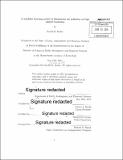A machine learning model of Manhattan air pollution at high spatial resolution
Author(s)
Keeler, Rachel H. (Rachel Heiden)
DownloadFull printable version (3.624Mb)
Other Contributors
Massachusetts Institute of Technology. Department of Earth, Atmospheric, and Planetary Sciences.
Advisor
Marguerite Nyhan.
Terms of use
Metadata
Show full item recordAbstract
A machine-learning model was created to predict air pollution at high spatial resolution in Manhattan, New York using taxi trip data. Urban air pollution increases morbidity and mortality through respiratory and cardiovascular impacts, and understanding and predicting it is a significant public health challenge. A neural network NARX model was created in MATLAB for each cell on a 250m square grid laid over Manhattan, for a total of 907 individual models across the city, for PM2 .5 , CO, NO2 , 03, and SO 2. In addition to standard meteorological inputs, data describing the distance and time traveled by taxis within each grid cell was used in the models. The models generally performed well, with mean R2 values between .62 (SO 2) and .86 (03), comparable to or better than previous models at this spatial scale. The model is computationally efficient enough to be run in real-time to aid citizens' and public health officials' decisions, and its efficacy suggests that taxi data is a valuable additional input to previous neural network pollution models.
Description
Thesis: S.B., Massachusetts Institute of Technology, Department of Earth, Atmospheric, and Planetary Sciences, 2014. 55 Cataloged from PDF version of thesis. Includes bibliographical references (pages 28-33).
Date issued
2014Department
Massachusetts Institute of Technology. Department of Earth, Atmospheric, and Planetary SciencesPublisher
Massachusetts Institute of Technology
Keywords
Earth, Atmospheric, and Planetary Sciences.